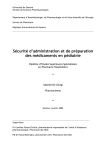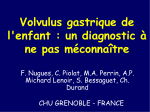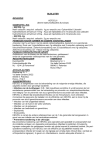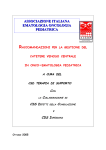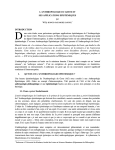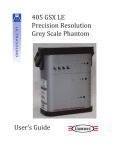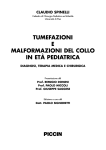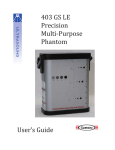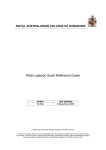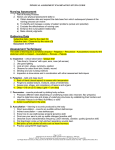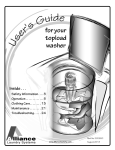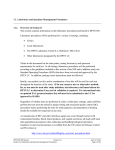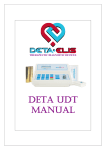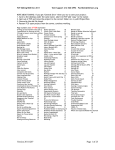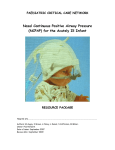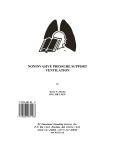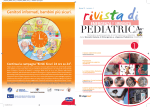Download Pediatric Surgery Resident Service Manual
Transcript
SERVICE MANUAL
for the PEDIATRIC SURGICAL TEAM
of the UNIVERSITY OF NORTH CAROLINA
at CHAPEL HILL
2007 REVISION
Compiled by:
Tim Weiner, MD
Daniel von Allmen, MD
J. Duncan Phillips, MD
Patty Lange, MD
William Adamson, MD
Don Nakayama, MD
Lynne Farber, MSN, CPNP
Amy Lamm, MSN, CPNP
This manual is dedicated to the residents, nurses and staff of the UNC Pediatric Surgical Service.
Special thanks to Jan Cheek, Craig Colliver MD, Jeff Abrams, MD, Tim Sadiq, MD.
Disclaimer: The opinions, protocols and medication dosages in this manual represent the biases of the
UNC Pediatric Surgeons and may not be appropriate for all patients.
1
The Pediatric Surgical Service
at the University of North Carolina
at Chapel Hill
INTRODUCTION
The mission of the Pediatric Surgery Service at UNC Hospitals is the surgical care and
consultation for patients 18 years and younger and the education of residents, students and staff. Our team
is available at all times.
This manual is designed as a concise reference for the routine problems we encounter. Unless
otherwise indicated, the protocols are uniform for all the attendings.
PEDIATRIC SURGICAL WISDOM (various sources)
“Bilious emesis in an infant is intestinal obstruction until proven otherwise.”
“Gastrointestinal bleeding and obstruction is dead or dying bowel until proven otherwise.”
“A newborn’s first enema should be a contrast enema.”
“A minor injury is one that happens to someone else’s child.”
“Common things occur commonly.”
First Rule of the Intern: “Never go down alone.”
“The enemy of good is better.”
“Never trust a naked baby.”
“A wide prep is a good thing.”
“For some reason, parents are greatly relieved to hear that what their child has is “going around”.”
“Learn to recognize when a baby is whispering to you that they are sick.”
“If it takes three people to hold a child down for an exam, they probably aren’t real sick.”
“Children and their grandparents get along so well, because they share a common enemy.”
“One of the disadvantages of children is they get old enough to give you presents they make at school.”
“Never pull a tube at night.”
“A good plan today is usually better than a perfect plan tomorrow.”
“If good intentions are combined with stupidity, it is impossible to out-think them.”
2
TABLE OF CONTENTS
The Essentials
Discharge Planning Checklist
Structure and Management of the Service p 7
Presentation Format
Surgical Issues and Preferences, including:
Pre-op Tests
NPO
Bowel Preps
Management of Coagulapathies
Peri-op Transfusion
Peri-op Antibiotics
Ambulatory Post-op care
Post-op Fevers
Post-op Analgesia
Other Post-op Pathways
Fluids/Electrolytes
Enteral Nutrition
Parenteral Nutrition
Feeding Access
Vascular Access, including:
The “line problem”
The infected line
tPA protocol
Broviac repair
Trauma, including:
Care of CHI
Clearing the c-spine
Protocol for Solid Organ Injury
Management of Neonatal Emergencies
Respiratory Distress
CDH
Bilious Emesis
Neonatal Intestinal Obstruction
Duodenal Obstruction
NEC
Abdominal Wall Defects
EA/TEF
Ambiguous Genitalia
Jaundice
Common Surgical Conditions
Appendicitis
Intussusception
Pyloric Stenosis
Hernias/Hydrocoeles/UDT
GER
GI Bleed
Constipation
Neck Masses
A Brief Oncology Primer
p 31
ECMO
Appendices
pp 4-5
p6
p8
pp 9-12
p 13
p 14
p 15
p 16
p 17
p 18
pp 19-20
pp 21-23
pp 24-27
pp 28-30
p 32
pp 33-45
3
THE ESSENTIALS
1. This service is closely supervised.
2. Use this litmus test: “If this was MY CHILD I’d want…”
3. As part of an emphasis on kid-friendly, family-centered, atraumatic care we promote the use of
adequate pain assessment and reevaluation, reduction of parent-child separation, teaching, and nonpharmacological (distraction, play) therapy, conscious sedation and appropriate analgesia.
4. Children are not given narcotics unless they are on a monitor and a senior team member is aware.
5. Morphine is used post-operatively at a dose of 0.05-0.1 mg/kg IV q 2 hr twice. Additional morphine
may be used thereafter, but a team member must first assess the child. An extensive discussion of
pediatric pain control is included in later sections of this manual.
6. Narcotics cannot be ordered by phone.
7. Narcotics and Ketorolac seem to have an excellent synergistic effect.
8. Bilious emesis in an infant is malrotation/volvulus until proven otherwise.
9. Glycerin chips, mineral oil, lactulose, MOM, Mirulax and senna (Ex-lax) work well for pediatric
constipation.
10. Wash your hands alot and especially in front of parents and nurses.
11. In infants, IV fluids and TPN must be carefully calculated. Fluids are calculated in cc/kg/day,
nutrition is calculated in kcal/kg/day.
12. TPN orders must be in by NOON.
13. Input and output should be closely reviewed 6-8 hours after surgery.
14. 1-2 cc/kg/hr is considered adequate urine output in infants and children.
15. In infants, mild hypovolemia or oliguria is treated by increasing the IV rate by 25% and reevaluating
the patient in 3-4 hours. Fluid boluses are not typically used.
16. Standard maintenance fluid in infants and children is D5 ¼ (quarter) NS with 20 mEQ/L KCl.
17. Resuscitation fluid (typically 1.5 to 2 times maintenance) is D5 ½ (half) NS with 20 mEQ/L KCl.
18. Resuscitation boluses are 20 cc/kg of LR (NS is preferred for HPS), or 10 cc/kg of blood or 5%
albumin.
19. High fluid rates or boluses can reopen a PDA in neonates.
20. The mean arterial blood pressure (MABP) in a neonate approximately equals their post-conceptual age
in weeks.
21. Children are given 12 hours to void post-op after routine surgery; thereafter a bladder scan is done and
if indicated a Foley is used and left in place for 12-48 hours. In and out (I/O) catheterizations are not
done.
22. An infant who is NPO for more than 4 hours requires an IV.
23. Bowel preps are not routinely done in infants less than 4 kilograms.
24. Standardized protocols and CPOE orders are in available for bowel preps.
25. Chronic care infants (i.e. “feeders and growers”) need a daily growth (weight) chart posted near their
bed
26. Sign above bed and order in chart after UGI/perianal surgery: “No manipulation of NGT/anal area.”
27. Write an order when a chest tube is placed on waterseal to avoid nurse confusion.
28. Orogastric (OG) or nasogastric (NG) tubes are removed when flatus has occurred.
29. Infant OG or NG tubes only come in two sizes (8 and 10 Fr “Replogle” tube). Do not use smaller
feeding (gavage) tubes for decompression. Avoid alar necrosis. Continuous suction is preferred.
30. OG tubes are preferred in neonates since they are obligate nasal-breathers.
31. Diets are usually advanced from clears/Pedialyte to regular/breastmilk or formula. Avoid carbonated
beverages for the first 24 hours post-op.
32. Use breast milk whenever possible. Encourage mothers to pump (it can be frozen).
33. Babies should gain 1% of their body weight (or about 10 gms/kg/day) each day.
34. Wound dressings are removed on POD #2.
35. Bathing may be done on POD #2.
36. Routine clinic follow-up is 2 weeks after d/c unless otherwise specified.
37. The Friday “NP Clinic” can be used for wound checks, GT problems, etc.
38. Several students should attend clinic.
39. Unless the child is a premature, routine pre-op labs are not usually necessary.
4
40. A blood bank sample should be obtained if the procedure carries a risk of blood loss (lysis of
adhesions, Nissen, splenectomy, NEC surgery, etc.).
41. Platelets and coagulation studies should be checked in any child undergoing a line placement with a
history of chemotherapy, bleeding diathesis or liver failure.
42. A pre-op platelet count above 50,000 for Broviacs and above 80,000 for ports is recommended.
Additional platelets should be available for the OR. The Peds H/O team often arranges this for their
patients.
43. Operative dictations are done by the attendings, unless specified.
44. A conscious sedation nurse (pager: 347-1131) is available during the day. At other times, the pediatric
or PICU residents can assist. The child should be NPO for 3 hours prior.
45. Many line issues (PICC placement, repairs, declotting) are managed through the Pediatric Specialty
Team (“PICC team”)
46. Urgent access in the smaller, injured child is obtained by cutdown at the groin and/or antecubetal
fossa. Intraosseous access is a good temporary option.
47. Diagnostic Peritoneal Lavage (DPL) is not routinely used in injured children. They either go to the
CT scanner or the OR.
48. Rectal exams are not routinely done in injured children, unless requested by the neurosurgeon.
49. A low threshold for intubation is used in the trauma room (GCS < 8, uncooperative, unstable, etc.).
50. Multi-system traumas are managed by our service (including all non-ventilator orders) for at least the
first 24 hours or until a clear transfer of service has been discussed.
51. Femoral arterial sticks for blood samples are not done in infants.
52. Inpatient and ER consults are accepted courteously and are seen promptly. A plan and follow-up to
the referral source is done in a timely fashion. Consult forms are filled out completely, leaving space
for an attending note.
53. Get a phone number and a physician name from outside referrals.
54. A form in the office for billing purposes documents procedures done on the floor.
55. Block OR days are M, T, W and F. Postings must be in by 10 am.
56. The 11 am intern/student lecture supersedes all other responsibilities.
57. The students should be rigorously coached by the senior residents in how to make directed, concise
and plan-oriented afternoon presentations. A mid-rotation evaluation is done by the Chief Resident.
58. All transfers are accepted without complaint or sarcasm.
59. Rudeness toward parents, nurses or referral sources is not acceptable professional behavior.
60. The goal of the service experience is to leave with much less anxiety about dealing with pediatric
surgical patients than when you arrived.
ESSENTIAL PEOPLE/PLACES:
Pediatric Surgery Nurse Practitioner, Lynne Farber
Amy Lamm
Chris Smith
Raleigh Clinic
Peds Admitting Resident
Peds ER
Ostomy Nurse
Peds Specialty Team (sedation, PICC, line care)
Admitting
Children’s PreCare
Children’s OR Front Desk
OR# 26
Children’s PACU
NICU
PICU
Peds Radiology
216-6715
216-3873
350-7796
783-7809
216-8160
966-1405
843-9234
347-1131
966-2041
966-2273
842-1501
843-1509
843-1537
966-3481
966-5491
966-7554
5
DISCHARGE PLANNING CHECKLIST
1.
The goal of a careplan is a safe and timely discharge. As you make a daily plan for a patient ask,
“What do I need to do to get this child home?”
2.
Children are ready for home when they no longer need daily PHYSICIAN care.
3.
When the patient is within 24 hours of discharge, inform the nursing staff and write an “anticipate
d/c” order.
4.
Think of d/c planning issues early (i.e. when the child is admitted).
5.
Order parent teaching (lines, stomas, and gtubes) early. Inform Lynne Farber or Amy Lamm.
6.
If the child will need home TPN, consult Pediatric GI one week before the expected d/c date.
7.
If the child will need home TUBE FEEDS, inform Lynne farber or Amy Lamm, Social Work and
order supplies listed in “Feeding Access” chapter.
8.
If the child will need Broviac care, home antibiotics, weight checks, wound or stoma care, order a
HOME HEALTH referral.
9.
OT, PT and Pediatric Rehabilitation should evaluate complicated trauma or neurologically
impaired children with feeding and/or other chronic issues..
10.
The Pediatric Surgery Social Worker can help with difficult d/c issues.
11.
Remind the family at d/c: WE ARE AVAILABLE AT ALL TIMES.
12.
Send a copy of the d/c summary to the child’s primary physician.
13.
Follow up visits should be in 2-3 weeks unless otherwise specified.
14.
Try to coordinate multiple f/u visits when possible.
15.
Discharge summaries should be dictated on the day of discharge and include:
a. primary care physician
b. consulting physicians
c. diagnoses
d. procedures and dates
e. d/c instructions
f. f/u dates
g. list of d/c medications
6
STRUCTURE AND MANAGEMENT OF THE SERVICE
UNC Services:
The office is located in 3010 Old Clinic Building. (966-4643/966-4220)
The clinic is located on the ground floor of the North Carolina Children’s Hospital; the phone
number is 966-1401.
Wake County Services:
Outpatient services in Raleigh are located at 3948 Browning Pl., #103 (off Six Forks Rd.). The
phone number is 919-783-7809.
Inpatient services are provided at WakeMed (919-350-8000). The Nurse Clinician for the
pediatric surgery team can be reached on beeper 393-6498
Conferences:
Monday (every week)
Monday (every week)
Thursday (2nd week)
Wednesday
Thursday (1st /3rd week)
Friday
11:00 a.m.
4:00 p.m.
7:45 a.m.
7:15 a.m.
5:00 p.m.
4:00 p.m.
4:00 p.m.
Ped. Pulmonary
Perinatal Care
Pediatric Chair
Grand Rounds
Morbidity/Mortality
Tumor Board
Service pre-op
Radiology Conf. Room
OR Conference Room
W&C Conference Room
Clinic Aud.
OR Conference Room
Pathology Conf. Room
OR Conference Room
Notes:
7
Presentation Format
1. Name, Diagnosis/Procedure, POD #
2. Significant events since last report.
3. Current weight and change in weight.
4. Pertinent vital signs.
5. Fluid/Electrolyte/Nutrition review:
a. total intake and output for 24 hours, including drains, chest tubes, NG
b. kilocalories/kg/day (normal : 60-120); gms fat/kg/day; gms protein/kg/day
c. fluid intake in cc/kg/day (normal: 80-140)
d. urine output in cc/kg/hr (normal: 1- 2), urine specific gravity
e. stool output in cc/kg/day (>40 is excessive)
f. stool guaiac/Clinitest (normal: <1% unless on breast milk)
6. Pertinent physical exam.
7. Lab results, pathology, radiology.
8. Medications, especially antibiotics (day #/total days planned).
9. Assessment.
10. Plan for next 24 hours, including how follow-up will be done.
ICU System Review (“head to toe” by SOAP format):
1. Overall condition/Key issues.
2. Neurologic.
3. Respiratory.
4. Cardiovascular.
5. Fluids/Electrolytes/Nutrition.
6. Renal.
7. Gastrointestinal.
8. Infection.
9. Hematologic
10. Musculoskeletal/Integument.
11. Psychosocial.
12. Concise Plan Summary/Avoidable Morbidity
Documentation:
All written orders should be concise, legible, dated and timed. Medication orders are calculated
on a per kilogram basis on the order sheet and double-checked; a pharmacist is readily available for
consultation (beeper 347-1378). Many CPOE protocols are in place.
Consult forms are fully completed by the resident in WEBCIS and forwarded to the attending.
8
SURGICAL ISSUES AND PREFERENCES
OR Scheduling:
Presently, we have block OR time available on all weekdays (2 rooms on Friday). We have a
hold on our room until 6 am for late postings.
Pre-operative Tests:
Pre-operative testing is individualized for each patient, but the majority of children will not
require any tests. Discuss this with the patient’s attending if uncertain.
Same-day Admission:
Infants who are full term (>37 weeks at birth) and less than 45 weeks post conceptual age and
former premature infants who are less than 55 weeks post conceptual age will require overnight
admission with cardiorespiratory monitoring after any elective surgery.
Case Order:
The outpatients should go first in ascending age, followed by the inpatients. Shorter cases are
generally done earlier. The senior residents should discuss the proposed case order with the attendings each
day to confirm their availability and preferences.
Transports:
Transports are arranged through the PICU or NICU service fellow or attending. Traumas are
triaged through the ER attendings who will assign a level of severity (red, yellow, green) and activate the
Trauma Response System.
NPO Status:
6-8 hours for solids, formula.
4 hours for breastmilk
2 hours for clear liquids (water, Pedialyte, clear juices).
6 hours before conscious sedation.
Bowel Preps:
1. A CPOE order sheet is available.
2. Do not use Golytely in infants less than 4 kg.
3. Track patient if they are not admitted by noon.
4. Order Golytely to the floor early in the day.
5. Plan to place an NG tube for administering Golytely in most younger patients.
6. Attending preferences may vary, you may need to individualize the prep.
7. In general: start IV; type and screen: Golytely 25cc/kg/hr for 4 hours; continue for another 2
hours if effluent still has solid material; Cefoxitin 25 mg/kg OCTOR; 10cc/kg warm saline
rectal enemas q 2 hr 3 times; may take water or Pedialyte after the prep; plan for on the table
stoma and rectal irrigations.
Minor Cases Done Outside the OR:
1. Includes: chest tubes, Broviac removal, venous access, rectal biopsies, I/Ds, Gtube changes.
2. Document clearly in progress notes under “PROCEDURE/PEDIATRIC SURGERY”.
3. Fill out minor procedure form in office and submit to the pediatric surgery secretary or dictate
an op note.
Pre-operative Considerations:
1. Consent obtained (Social Work can help).
2. Coagulopathy evaluated/corrected.
3. Blood availability confirmed.
4. Decide where to meet the family post-op.
5. Check for rashes/URI.
6. Mark for ostomy/Ostomy Nurse consult
7. Check effectiveness of bowel prep.
8. Order peri-operative antibiotics.
9. Order stress steroids, if indicated.
10. X-rays available. Pathology notified.
11. ICU notified and/or other services notified (ENT, Heme/Onc).
12. Inform OR of special instruments/preps.
Management of Coagulopathies:
9
1.
2.
3.
4.
Stop heparin infusion 6 hours before OR.
Confirm that neonates have been given vitamin K (1 mg IM).
10 cc/kg of FFP to normalize INR, if indicated.
5 cc/kg (infant) or 4 units (older child) of platelets the night before surgery with the same
amount available to be given in the OR. (1 unit=30-50 cc and 1 unit per 5 kg will increase the
platelet count by 50,000).
Perioperative Transfusion:
1. In most cases, an infant’s hematocrit should be kept above 30% (higher if they are on
oxygen).
2. Premature infants may require a pre-operative CBC if they appear anemic.
3. PRBC transfusions are given as 10-15 cc/kg over 4 hours; Lasix is not routinely given.
4. Dextrose (D5 or D10) is provided during the transfusion (preferably through a second IV);
dextrostix are checked q 1-2 hrs.
5. Recall that infants have a physiologic anemia at 6-8 weeks of age.
6. Sickle cell patients may require pre-operative transfusion therapy.
7. Neonatal blood bank samples are good for 4 months.
8. Always inform the parents and obtain consent before transfusion. If the family are Jehovah’s
Witnesses, inform the attending directly and before surgery; a special consent form is
available.
Perioperative Antibiotics:
Neonates/Infants:
Ampicillin and Gentamycin
Children>6 months:
Kefzol (+/- Flagyl) (if GI/GU tract opened)
Broad spectrum:
Ampicillin, Gentamycin and Clindamycin/Metronidazole or
Zosyn.
CLEAN CASES (antibiotics not indicated): hernia, hydrocoele, orchiopexy, circumcision, small
skin lesion, and pyloromyotomy, Nissen. (Drs. Weiner and Adamson prefers antibiotics on these
cases.)
CLEAN CASES (antibiotics indicated): all newborns, Broviacs, splenectomy, cystic hygroma,
nephrectomy
CLEAN/CONTAMINATED (antibiotics indicated): simple appendicitis, gastrostomy,
cholecystectomy, lobectomy, congential neck lesion, GI/GU tract opened
CONTAMINATED (broad-spectrum coverage): bowel spillage/perforation, complicated
appendicitis, peritoneal/thoracic abscess, infected wound
SBE Prophylaxis:
1. All unoperated congenital cardiac defects except uncomplicated ASD.
2. Rheumatic and other acquired valve abnormalities.
3. All post-operative cardiac patients.
4. Previous episode of SBE.
5. Hypertrophic cardiomyopathy.
6. Mitral valve prolapse.
Undergoing:
1. Dental procedures.
2. Procedure involving respiratory mucosa.
3. Procedure involving infected tissue.
4. Procedure involving GI or GU tract invasion.
See Appendic and/or ask Pediatric Cardiology or Pediatric Infectious Disease for timing, dosage and
antibiotic recommendations.
10
In the Operating Room:
1. Our team should accompany ICU transports.
2. The resident surgeon should be in the room upon the patient’s arrival. (One 2006 minute of
OR time is over $14).
3. Keep the infant warm with high room temperatures, warming blankets and overhead lamps.
4. Anesthetic preparations take priority.
5. Review relevant x-ray films.
6. Use a headlight liberally.
7. Needle-tip Bovie, Thompson retractor.
8. Wide soap and paint prep three times; relatively “dry” prep.
9. Vicryl, PDS preferred absorbable suture.
10. Evaluate gallbladder, kidneys, and intestinal rotation when possible.
11. Mark and orient specimen for pathology.
12. ¼ % Marcaine (1 cc/kg) into the wound or caudal block by anesthesia.
13. Meticulous subcuticular closure.
14. Neatly applied steri-strips, collodion and/or dressing.
15. Attendings generally do the dictations.
16. Diagram/record important operative findings.
17. Tabulate fluids carefully.
Post-operative Considerations:
1. Assist in ICU transports.
2. All upper torso central lines placed percutaneously get a CXR post-op.
3. Write fluid orders carefully.
4. Evaluate fluid status in 4-6 hours post-operatively.
5. Urine output should be 1-2 cc/kg/hr.
6. Avoid fluid boluses in infants.
7. Start chest physiotherapy/mobilization early.
8. Consider bladder catheterization only after 10-12 hours.
9. Cardiorespiratory monitor for same-day, elective infants.
10. Dressings off on POD #2.
11. NGT out when flatus occurs; watch for alar pressure.
12. Antibiotic regimen per attending.
13. Senior resident supervision for CT, Broviac removals.
14. Consult stoma nurse early.
15. Anticipate discharge planning issues (weight checks, home TPN, antibiotics, feeding pumps,
CR, apnea monitors).
Routine (Ambulatory) Post-operative Care:
Most parental questions/concerns can be handled by telephone by an experienced surgical resident.
However, IF THERE IS ANY DOUBT IN YOUR MIND ABOUT A PATIENT, IT IS ESSENTIAL
THAT YOU CONSULT WITH THE CHILD’S ATTENDING, OR THE ATTENDING ON-CALL.
Anesthesia: General endotracheal anesthesia is often used for pediatric surgical procedures. Thus, it is not
uncommon for children to have transient nausea and vomiting during the first 4-8 hours after surgery. This
usually does not require medical treatment. Reassure the parents that this should pass. If it persists beyond
8 hours they should call back. Sore throats from intubation are also common and can be eased by sore
throat lozenges or Chloraspetic spray.
Pain: Incisional pain is usually greatest the first evening after surgery and generally diminishes over the
next few days. Tylenol at a dose of 15 mg/kg q 4 hours is often adequate. Suppositories at 20 mg/kg can
be used if the child is nauseous. Post-op pain that is more severe can be handled with Tylenol with
codeine, Percocets or oxycodone (elixir or tablets).
Dressings: Most incisions are closed with absorbable (subcuticular) sutures covered by Steri-strips and
collodion. Bandages on top of the Steri-strips can be removed on POD #2. The Steri-strips can be
removed when they begin to peel off. Small amounts of blood on the dressing are usually not cause for
concern; marked redness, drainage or pus is concerning. If the gauze dressing becomes soaked with blood,
11
water or urine, it should be removed and replaced. It is usually safe to begin bathing or showering of the
surgical site on POD #2. The site should be kept clean and dry.
Fever: Low-grade fevers up to 100.5 C are common in the first 36 hours after surgery and are usually due
to atelectasis. Tylenol and pulmonary toilet is typically all that is required. Persistent and/or high fevers
(>101.5 C) may indicate a more serious problem and should be investigated (see below).
Follow-up: Routine follow-up is generally 1-3 weeks after the operation. Reassure the parent that a
member of the surgical team is available at all times to answer questions or see the child in the ED. Offer
them a follow-up phone call if they seek advice about a problem.
Post-operative Fevers:
1. The majority of early fevers are pulmonary (atelectasis). Order chest physiotherapy.
2. Catheter infections are considered in any child with a central line.
3. Examine the patient:
a. check the wound
b. examine IV sites
c. listen to the chest
d. look in the ears (NGTs in particular can cause OM)
4. Fever work-up, if clinically indicated:
a. CBC/diff
b. Urinalysis and/or cx if child is catheterized
c. Sputum cx if on a ventilator
d. CXR if pulmonary symptoms/poor mobilization
e. blood culture via catheter if the child has a central line
f. stool cultures (routine micro, toxigenic E. coli, rotavirus) if diarrhea
g. stool cultures, KUB if Hirschsprung’s patient (enterocolitis)
h. KUB if gastroschisis patient (late NEC)
i. LFTs, blood cultures if s/p Kasai (cholangitis)
4. Routine peripheral blood cultures are generally not done.
5. Epidurals are usually removed.
12
Post-operative Analgesia:
1. Narcotics should not be used in newborns unless they’re in a monitored ICU setting.
2. Narcotics should be used carefully in infants and young children. This must be discussed
with a senior resident and/or attending. The dose is 0.05 mg/kg q 1-2 hours to 0.1 mg/kg q
2-3 hours for infants < 6 months, and 0.1 mg/kg hours q 2-3 hours for children older
than 6 months THE CHILD MUST BE ON A CR MONITOR/PULSE OXIMETER.
Reorders are discussed by the team every day. Narcotics cannot be ordered by phone.
3. Toradol and narcotics seem to have a synergistic effect.
4. A child who has had a narcotic caudal in the OR should not get further narcotic for 6-8 hours
unless this is discussed with the attending or anesthesia team.
5. PCA may be used in children over 5 years (call Pharmacist for dosing).
6. The Acute Pain Service manages epidurals. A Foley is used until 6 hours after the epidural is
removed.
7. Non-narcotic analgesics:
a. TYLENOL
15 mg/kg pr/po q 4 hours
b. MOTRIN
4-10 mg/kg po q 6-8 hours
c. TORADOL
1 mg/kg LOAD; 0.5 mg/kg/dose q 6-8 h, 48 hr. limiti
d. EMLA CREAM
2.5 gms to skin for 1 hour
e. 1 % LIDOCAINE
maximum 4.5 mg/kg/dose (buffer 9:1 L:NaBicarb)
f. ¼ % BUPIVICAINE
maximum 1 cc/kg/dose
7. Narcotic analgesics
a. MORPHINE
0.05-0.1 mg/kg q 2-4 hours
b. CODEINE
0.5-1.5 mg/kg po q 4 hours
c. Tylenol with CODEINE
<1y:1-2cc q6-8 h; 1-3y:2-3cc q6-8 h; 3-6y:5cc q6-8h
d. OXYCODONE
0.05-0.15 mg/kg/dose q 6 hours
e. PERCOCET
½-1 tablet po q 4-6 hours
f. FENTANYL
0.5-1.0 MCG/kg IV q 2-3 hours
8. Sedatives
a. VERSED
0.05 mg/kg/dose IV, repeat once
b. VALIUM
0.05 mg/kg/dose IV: 0.2-0.3 mg/kg po
c. ATIVAN
0.05 mg/kg/dose IV or po
d. CHLORAL HYDRATE
25-50mg/kg po/pr q 6-8 hours
e. BENADRYL
1 mg/kg IV/po q 6 hours
9. Reversals
a. NARCAN
0.005-0.01 mg/kg/dose q 2-3 minutes
b. FLUMAZENIL
<20 kg: 0.01 mg/kg IV; >20 kg: 0.2 mg IV
Atraumatic Care
As part of the NC Children’s Hospital emphasis on atraumatic care we promote the proper
training of healthcare providers in the recognition, assessment and timely intervention for children
experiencing perioperative pain and anxiety. Resources including pediatric pain scales, Child-life
therapists, a Pediatric Anesthesia consult service, nurse specialists and conscious sedation are available.
Conscious Sedation
Healthcare providers including the Pediatric Specialty Team (843-0977) and certified PICU and
ED physicians are available to provide and monitor conscious sedation during procedures on pediatric
patients. The child should be NPO for 6 hours (solids) and 2 hours (clears) before the sedation. A preprocedure form and consent must be filled out.
A trained healthcare provider does continuous monitoring of VS and saturation. Emergency
equipment including oxygen, suction, intubation and resuscitation is immediately available.
Medications and recommended dosages are listed above or in the Appendix.
13
OTHER PEDIATRIC SURGERY PROTOCOLS AND PATHWAYS
(2007 Note: CPOE is now available for many of these)
Post-op Pectus Repair:
1. CXR in PACU
2. Clears on day 1, advance
3. Hospital bed, drain care
4. Epidural, 2-3 days
5. PCA, 2-4 days
6. Start Oxycodone, Motrin after PCA d/ced
7. Remove any drains when <40 cc/d
8. No heavy lifting for 8 weeks
Post-op Pyloromyotomy
1. see “Pyloric Stenosis” section in this manual
Post-op Nissen Fundoplication
1. NGT overnight, d/c in AM; meds per NGT or GT
2. If neurologically normal begin clears at 24 hours
3. If neurologically impaired begin clears at 48 hours
4. If Gtube-dependent, continuous feeds initially
5. Ask attending when to switch to bolus feeds
6. “No chunk” diet, no carbonated beverages diet for 4 weeks
7. Change Gtube to MIC-Key at 3-6 weeks (attendings vary)
8. Nutritionist consult.
Chest Tube management
1. If child less than 10 kg, suction to -10 cm/H2O
2. If child 10-20 kg, -15 cm/H2O
3. If > 20 kg, -20 cm/H2O
4. TEF, CDH repair, waterseal only
5. Portable CXRs with management changes
6. Suction to waterseal at 48 hours post-op or 24 hours after airleak stops and lung is fully reexpanded
7. Leave at waterseal for 24 hours, CXR prior to removal
8. If spine exposure chest tube: waterseal until daily output < 100cc or 1 cc/kg/d
9. Return to suction if lung drops
10. EMLA to tube site; conscious sedation as indicated
11. Senior resident supervision/assistance of tube removal
12. Post-pull CXR and occlusive dressing for 48 hours
Post-op Appendicitis
1. see “Appendicitis” section in this manual
Feeding after routine intestinal surgery
1. Remove NGT when flatus or second BM (and NGT output clear)
2. Offer clears 6-24 hours later
3. Advance to solids/formula after second feeding
Feeding tube/GER workup
1. see “GER” section in this manual
Post-pullthrough Hirschsprung’s enterocolitis
1. (Rectal exam yields explosive, foul-smelling stool.)
2. (KUB shows colonic dilation and/or colon air-fluid level.)
3. NPO overnight, clears in AM if improved
4. IVF; Flagyl
5. First (admission) rectal irrigation by surgeon with 10cc/kg warm saline
6. Rectal tube (Foley with side holes) taped to buttocks (remove at 24 hrs)
7. Nurses to irrigate q 6 hours, interval to q 8-12 hours with improvement
8. Advance diet, change to po Flagyl for 2 weeks
9. Consider home irrigation
14
FLUIDS
Maintenance Fluid:
The standard pediatric maintenance fluid is D5 or D10 ¼ (quarter) NS with 20 mEQ/L KCl.
Rates above maintenance should use D5 ½ (half) NS with 20 mEQ/L KCl. Blood sugar is monitored in
neonates by dextrostix q 4-8 hours to avoid hypoglycemia. The hourly maintenance rate (which
corresponds to 100 cc/kg/24 hr) is calculated by weight:
0-10 kg
4 cc/kg/hr times weight in kg
11-20kg
40 + 2 cc/kg/hr times kg above 10 kg
>20kg
60 + 1 cc/kg/hr times kg above 20 kg
Over the first week of life (during their physiologic, obligatory diuresis), infants require less
maintenance fluid in a 24 hour period:
DOL #1-2
65 cc/kg/24 hr of D10W, add electrolytes after 24 hours
DOL #3-7
85 cc/kg/24 hr
DOL #8+
100 cc/kg/24 hr
Resuscitation of Severe Dehydration:
1. Bolus with LR or NS at 20 cc/kg over 30 minutes.
2. Repeat if perfusion remains poor.
3. IVF: D5 ½ NS at 1.5 times maintenance (6 cc/kg/hr times weight in kg if less than 10 kg).
4. Add 20 mEQ/L KCl after first void.
5. Monitor lytes and glucose closely.
Replacement of Significant Fluid Losses:
Gastric:
D5 ½ NS with 20 mEQ/L KCl at 1 or ½:1 q 4-8 hours
Third space:
D5 ½ NS with 20 mEQ/L KCl at 1.5 -2 times maintenance
Chest tube:
LR 1:1 q 4-8 hours
Ileostomy:
½ NS with 20 mEQ/L KCl or LR 1:1
Diarrhea:
LR with 20 mEQ/L KCl 1:1
Fistulae:
check output electrolytes and match fluid; replace volume lost 1:1
ELECTROLYTES
Maintenance:
Na and Cl
3 mEQ/kg/24 hr
K
2 mEQ/kg/24 hr
Hypokalemia:
1. “K run” of 1-2 mEQ KCl in 50 cc maintenance fluid at child’s maintenance IV rate.
2. Recheck serum level.
3. Repeat until K >3.5.
4. A CV line may be necessary to avoid painful vein sclerosis.
Hyperkalemia:
1. Recall that heelsticks can cause an artifactual elevation.
2. Place on cardiac monitor.
3. ICU if ECG changes (peaked T-waves).
4. Calcium gluconate at 30 mg/kg.
5. 1 gm/kg D25 glucose and 0.3 u/kg regular insulin.
6. Kayexcelate at 0.5-1.0 gm/kg po/pr.
Refer to the Potassium and Calcium Dose Standardization Table in the Appendix
15
ENTERAL NUTRITION
The enteral route should be used whenever possible. Breast milk is the preferred baby food.
Most infants feed on a q 3 hour schedule. Gavage (per OGT) feeds are used in premature infants. The
nursing staff, the nutritionist, the Pediatric Gastroenterology Service and the Pediatric Rehabilitationist
(Joshua Alexander, MD, beeper 216-1840) have experience in children with chronic feeding difficulties.
Daily Requirements:
low birth weight
120-160 kcal/kg/day
2-3 gm protein/kg/day
0-6 months
100-140 kcal/kg/day
2-3 gm protein/kg/day
6-12 months
90-110 kcal/kg/day
2 gm protein/kg/day
1-3 years
1300 kcal/day
23 gm protein/day
4-6 years
1800 kcal/day
30 gm protein/day
7-10 years
2400 kcal/day
36 gm protein/day
Increased caloric requirements are anticipated with severe injury or illness, sepsis, fever, after
surgery and with inflammatory bowel disease.
Caloric Densities:
Standard formulas and breast milk are 20 kcal/30 cc (1 oz). Formulas with greater caloric value
are available (24, 27 and 30 kcal/30 cc) but have higher osmolar loads and can cause diarrhea.
breastmilk/standard formula (20 kcal/30 cc)
0.67 kcal/cc
breastmilk with fortifier (24 kcal/30 cc)
0.8 kcal/cc
24 kcal/30 cc
0.8 kcal/cc
27 kcal/30 cc
0.9 kcal/cc
30 kcal/30 cc
1.0 kcal/cc
Pediasure
1.0 kcal/cc
supplements:
MCT oil
7.7 kcal/cc
Microlipid
4.5 kcal/cc
Feeding Programs:
Post-operative goal feeds in otherwise healthy infants can be initially targeted at 100 kcal/kg/day
and adjusted up if the daily weight gain (1% of body weight/day) is not achieved. Breastmilk or standard
formulas provide 100 kcal/kg/day or 150 cc/kg/day of fluid when given at 18 cc/kg/3 hr feed. A growth
chart is essential for monitoring these babies.
Infants with significant intestinal absorption problems (prematures, post-NEC, gastroschisis, short
gut, extensive resections) may require a slower feeding advancement to prevent malabsorption. It is better
to achieve fluid goals before nutritional goals so that the infant is not dependent on IV access. In general,
volume and tonicity are not advanced simultaneously. When the tonicity of the feeds are increased
(starting at ¼ or ½ strength) the stools are monitored for malabsorption of sugars (>1 % Clinitest, stool
volume > 40cc/kg/day). TPN is tapered off over 1-2 days at ¾ of enteral goals.
Children with fluid restriction requirements (cardiac, renal patients) may require higher density
formulas. Infants with significant cardiac or pulmonary compromise may require feeding tubes to decrease
the work of feeding. Meconium ileus (CF) infants will require pancreatic enzymes.
Older children can be advanced from clears to solids rapidly as GI function returns following
abdominal surgery. Avoid carbonated beverages initially.
Formulas:
cow’s milk, lactose tolerant
Similac, Enfamil, Good Start
premature
Enfamil Premature, Similac Special Care
cow’s milk tolerant, lactose intolerant
Lacto-free
cow’s milk, lactose intolerant (soy-based)
Isomil, Prosobee
cow’s milk, lactose, soy intolerant (pre-digested)
Pregestimil, Alimentum, Nutramigen
(pre-digested) >1 year
Peptamen Jr.
high MCT (chylous leak, fat malabsorption)
Portagen
CHO intolerant
RCF (Ross), 3232A (Mead)
elemental, amino acid (if > 1 year)
Neocate, (Neocate 1+)
low solute (renal impairment)
Similac PM 60/40
standard, lactose-free, > 1 year
Pediasure, Kindercal, Vivonex
16
PARENTERAL NUTRITION
Ordering TPN has been greatly simplified by the standard order sheet. The orders must be in by
12:00 noon. Daily recalculations of the total fluids and calories must be done until the child is on a stable
regimen. Thereafter, recalculations are done periodically to adjust for weight gains. Assistance is
available from the pharmacist, the nutritionist and the Gastroenterology service.
Basic Numbers and Principles:
D5
0.17 kcal/cc
D10
0.34 kcal/cc
D12.5
0.42 kcal/cc
D15
0.51 kcal/cc
D17.5
0.60 kcal/cc
D20
0.67 kcal/cc
D25
0.85 kcal/cc
D30
1.00 kcal/cc
10% lipid
1.00 kcal/cc
20% lipid
2.00 kcal/cc
Dextrose starts at D10 or D12.5 and advances 2.5 %/day to a target of D25 (D15 if the catheter is
not central). Do not advance if the child is hyperglycemic or hyperglycosuric.
Protein starts at 1.0 gm/kg/day and advances to a goal of 3.0 (infants) or 2.0 (children) by 0.5
gm/kg/day. The calorie:nitrogen ratio should be 150-200 calories:gm nitrogen. Proteins are not considered
in the caloric calculation.
Lipids start at 1.0 gm/kg/day and advance to 3.0 by 0.5 gm/kg/day. Central access is not
necessary to give 20% Intralipid. Lipids are not given if the infant has hyperbilirubinemia.
The final carbohydrate:lipid caloric ratio should be 50:50.
Children on long-term TPN, should be cycled to less than 24 hours infusions to avoid liver
damage and cholestasis.
Fetal mineral accumulation occurs in the last trimester. Therefore prematures tend to be mineral
deficient and require increased supplementation.
Monitoring TPN:
1. Daily weights.
2. Daily total fluid and calorie calculations.
3. Specific gravity and urine for sugar until TPN maximized.
4. Lytes, BUN, glucose, CBC monitored closely until TPN maximized.
5. LFTs, bilirubin, protein, albumin q week.
6. Triglycerides q week to check for fat overabsorption.
7. Alkaline phosphatase q week in prematures (elevated in neonatal hypocalcemia).
8. Septic evaluation if blood/urine sugars become unstable.
A Simple TPN Calculation Technique:
Example: Five-day old, 4 kg infant with central access starting on TPN.
1. Select target fluid volume (120 cc/kg/day would be appropriate in this child)
2. Calculate hourly IV rate for above (120 divided by 24 times 4 = 20 cc/hr).
3. Start lipids at 1.0 gm/kg/day and use the following shortcut formula: cc/hr of 20% lipids =
weight in kg (4) times gm/kg/day of lipids desired (1.0) times constant factor of 5 divided by
24. In this case, 0.8 cc/hr. Thereafter, advance lipids 0.5 gm/kg/day.
4. Subtract lipid rate (.8) from total hourly rate (20) to give hourly rate of dextrose (19.2 cc/hr).
Start dextrose at D12.5 at this rate. Thereafter, advance dextrose 2.5%/day.
5. Start protein at 1.0 gm/kg/day. Thereafter, advance 0.5 gm/kg/day.
6. Add appropriate vitamin, minerals, trace elements.
7. Calculate calories for day #1 at selected volume of 120 cc/kg/day: D12.5 at 19.2 cc/hr + 20%
IL at .8 cc/hr (48 + 10 = 58 kcal/kg/day.
8. Advance carbohydrate, protein, lipids each day to maximums and recalculate calories each
day. Advance fluid volume to obtain more calories as needed to achieve weight gain.
9. Calculate contribution of enteral calories and fluid as the infant begins to feed by mouth.
17
FEEDING ACCESS
Gastrostomy Tubes:
Gastrostomy tubes (GT) are placed for a variety of reasons (failure to thrive, severe GER,
neurologic impairment, pure EA) and are often done with an anti-reflux procedure. All patients who
receive a GT, should also receive a copy of the GT Teaching video. The GT is initially placed as a Pezzar
or Malecot tube or primary MIC-Key and converted to a Foley tube, MIC-Key or Bard Button when the
tract is mature (3-6 weeks). The tract can seal rapidly (4-6 hours) so that a dislodged tube should be
replaced with a similarly sized Foley as soon as possible. The Foley balloon must not be blown up in or
allowed to migrate into the pylorus or duodenum. Consider this possibility in a child with a GT and acute
onset emesis. The balloon should not be filled beyond 5 cc. Only water or saline should be used in the
balloon.
A contrast study should be obtained if:
1. the tract is less than 3 weeks old
2. the replacement was uncertain
A properly replaced tube should drain into the stomach with gravity and aspirate gastric contents. An
“Accidental dislodgement” protocol is described below.
Granulation tissue often develops at the GT site and is managed with periodic applications of
silver nitrate. GT sites rarely get infected. Excoriation can be treated with application of a barrier cream to
the peri-GT area. More complex problems may benefit from a Wound/Stoma Nurse consult (843-9234)
Leaking GTs can be managed by downsizing the tract with a smaller Foley for 24-48 hours and
then replacing the previous tube. Occasionally, “overfilling” a MIC-Key balloon by 1-2 cc will create a
tighter seal.
MIC-Keys come in a variety of diameters (14, 16, 18 Fr) and stem sizes (1.2, 1.5, 1.7, 2.0 cm, as
measured from the top to the top of the balloon). The stem size can be estimated or sized with a measuring
device. MIC-Keys are kept in the OR or ordered from Central Supply (see stock list). Bard Buttons are
kept in the OR and in central supply.
Gastro-jejunostomy (GJ) tubes are usually placed by Interventional Radiology. Problems and
questions can be referred to them. A MIC-Key GJ tube is now available.
The Nurse Practioners are an important resource in the care, teaching and management of GTs
and gastrostomy sites. They will review our GT video before d/c.
Feeding Access Home Care Supplies, write prescriptions for following:
-portable pump
-feeding bags (31/month)
-formula or nutritional supplement
-MIC-Key gastrostomy tubes (3/year)
-Secur-Lok extension sets (5/box) (CD# 0121-12)
-5cc syringes, 60cc catheter-tip syringes (4/month)
-2x2 gauzes (box of 100)
-1” paper tape
Emphasize that GT extension sets should be removed and cleaned when not in use and secured at
all times when in use. Extension sets should be loosely taped when in use, so as to exit the GT stoma
perpendicular to the skin in order to prevent pressure sores and “coring” and enlargement of the GT site.
18
Accidental Dislodgement of Gastrostomy Tube:
1. Replace G-tube with Foley catheter (10, 12, or 14 Fr).
2. Attempt to aspirate gastric secretions from Foley G-tube to verify placement.
3. Contact Pediatric Surgery.
4. If the gastrostomy tube site is “mature” (present longer than 4-6 weeks) and if aspiration
of the tube confirms intraluminal position with the return of gastric juice and/or formula), no
contrast study is indicated (unless, for some other reason, the clinician is concerned that the tube
is not appropriately positioned). If the gastrostomy tube is “fresh” (surgically placed within the
past 4-6 weeks, a contrast study should be obtained.
5. A contrast study ("Tube Injection Verification Study") should ideally be performed under
fluoroscopy in the Radiology Department by the Pediatric Radiologist. However, if the study is
ordered emergently (at night or on weekends), the study may be performed at the bedside by the
fellow/resident or by the Pediatric Surgery resident (after discussing the plan with the attending
neonatologist and attending surgeon) as a "one-shot study" (with bedside KUB). Review of the KUB
may be by the Radiology Resident.
6. If the G-tube appears to be appropriately replaced in the gastric lumen, the tube should be taped in
place and feeds should be held until the morning (pending review by the Pediatric Radiologist). The
study should be repeated if the Pediatric Radiologist believes the study is inadequate.
If the tube appears to be out of the stomach, the resident should immediately contact the Pediatric
Surgery Attending or Senior Resident on call due to the potential risk of leakage of gastric juice and
feeds into the peritoneal cavity.
19
VASCULAR ACCESS
General Information:
The Pediatric Surgery Team provides a valuable and experienced venous access service to the
Children’s Hospital. Always receive the line consult courteously and in a reasonable way determine if the
request for our expertise is appropriate and necessary. A teaching video is now available for families to
review.
Short-term peripheral access can be obtained by the IV team, the NICU and PICU nurses, the
senior Pediatric residents and the Pediatric Anesthesia service. The PICU team can do percutaneous
subclavian and femoral lines. Peripherally inserted central catheters (“PICC lines”/Perqu-Caths) can be
done by the neonatal nurse practitioners, Interventional Radiology and/or an IV team “PICC line nurse”.
Percutaneous or cutdown long-term, central access (central lines, Broviacs, Port-a-caths) and
venous cutdown PICC lines are offered by our service, usually as an OR or ICU-based procedure. The
insertion site and the type of line will be determined by the indication, length of time needed, risk to the
patient, coagulapathies and ongoing infections.
Lines available: 2.7, 4.2, 6.6, 9.6 Fr single lumen Silastic catheters (“Broviac”)
7, 10 Fr double-lumen Silastic catheters (“Hickman”)
12.5 Fr triple lumen Silastic catheters (“Hickman’)
2, 3 Fr PIC lines
6.6, 9.6 Port-a-caths
Sites often used include the external jugular, facial, internal jugular, subclavian, saphenofemoral, antecubetal veins.
Supplies are kept in Central Supply (see stock list), W&C ORs and in the NICU. Repair kits are
kept in Central Distribution (see stock lists). Ask the Unit Clerk to order one ot the floor Stat.
Be aware that Port-a-caths are accessed with a special, non-coring (Huber) needle.
The “line problem” Consult:
1. The Pediatric Surgery NPs and the PEDIATRIC SPECIALTY TEAM (843-0977) and the
Pediatric Oncology nurses are highly experienced in the management of catheter problems.
Ask for their assistance early. Stay involved.
2. Did we put in the line? Refer to the PICU team or Interventional Radiology if appropriate.
3. Is it occluded? Try flushing using sterile technique with a 10 cc syringe of saline. Try an
instillation of tPA(see below). Check the tip position and catheter course by CXR.
4. Is there evidence of extravasation (pain, local swelling)? Obtain a contrast study.
5. Is the skin stitch out? Do nothing if the catheter has been in for more than 2 weeks.
6. Is the cuff exposed? The catheter will probably need to be replaced.
7. It won’t aspirate blood? Try a tPA instillation. Inform the primary team that catheters are
not replaced if they flush but don’t aspirate.
8. Is there diffuse upper torso swelling? Consider major venous thrombosis and evaluate with
either contrast or US. Plan to remove the catheter.
9. Is there leg swelling? Elevate the leg if distal pulses are OK and capillary refill is brisk.
Remove the catheter if the swelling significantly worsens.
10. Has it migrated? Continue to use it if it works. Replace if central access is needed.
11. Is it broken on the external portion? Obtain the appropriately sized repair kit from Ostomy
Nurse office/In-patient Pharmacy and repair aseptically (see stock list).
12. Is exit site red? Do nothing unless the catheter is infected. Remove the skin stitch if
appropriate.
The Infected Line:
In pediatric patients, vigorous attempts are made to preserve central lines which become infected.
The protocol (available thorough the Pediatric Specialty Team) at UNC includes:
1. Documenting the infection by a culture through the line.
2. Line removal is often necessary if the line has yeast in it or if the cuff or tunnel is draining
pus.
3. Empirically start Vancomycin (15 mg/kg IV q 8 hours, levels at third dose) and Cefotaxime
(50 mg/kg IV q 8 hours) after the culture is drawn. Stop the antibiotics if the initial culture is
negative at 48 hours.
20
4. Repeat line culture on the third or fourth day of antibiotics.
5. Line removal if that culture remains positive.
6. Peripheral access and antibiotics for 24-48 hours.
7. Repeat culture at 24-48 hours.
8. Central line replacement as needed.
tPA Protocol:
1. Order 2mg/2cc tPA (Alteplase) to the floor.
2. Aseptic technique.
3. Instill tPA into catheter (0.2cc for 2.7 Fr, 0.3cc for 4.2/5.0 Fr, 0.7 cc for 6.6/7.0 Fr, 2.0 cc for
9.6 Fr, 1.2 cc for 6.6 Fr Port)
4. Allow to dwell for 2 to 24 hours.
5. Aspirate remaining tPA and attempt to flush with saline (½-life is 5 minutes, so it may be
forward-flushed if it does not aspirate).
6. If successful, restart IV fluids or heplock.
7. Replace line as needed if two attempts fail.
Line Removal:
Port-a-caths are removed in the OR as a scheduled (ambulatory) surgery.
Broviacs in infants are removed on the floor with a combination of restraints and local anesthesia.
In older children, conscious sedation on the floor and in the Heme/Onc clinic or removal in the OR is done.
Care is taken to dissect the cuff and avoid breakage of the catheter. Document the procedure through the
office for billing purposes.
The nurses can remove non-tunneled central lines and PICC lines.
Broviac Repair:
Breaks distal to a Broviac catheter exit site (e.g. external portion) can be repaired. Disruptions
between the skin and tip (internal portion) require catheter replacement. Repair kits are kept in Central
Distribution; see the Stock List in the Appendix. During the day, the NPs can assist with the repair.
1. Contact the attending on call before doing the repair.
2. Evaluate the catheter and take off the dressing. If the cuff is exposed, the catheter should be
replaced. If the tubing “balloons” with infusion, tPA should be instilled after the repair.
3. At least 2 cm of external catheter is needed to allow a repair.
4. Obtain a pIV if the child requires continuous access.
5. Order the appropriate repair kit to the floor (see Stock List).
6. Review the instruction book thoroughly.
7. Have experienced supervision during your first 3 repairs.
8. Sedation is typically not necessary. Informed consent is not necessary.
9. All technique must be sterile.
10. Repair the catheter as distal as possible.
11. Equipment: blue plastic clamp, sterile scissors and #11 blade, sterile towels, Betadyne prep,
sterile gloves, mask, 2x2 gauze, heparin flushes (10 u/cc or 100u/cc), tongue depressor. A
cutdown or similar tray may also be useful.
12. The catheter should be occluded near the skin (non-sterile) with a non-crushing clamp to
prevent bleeding and air emboli.
13. Use silicone glue included in kit. Avoid getting glue into the lumen.
14. Catheter should aspirate and infuse easily after the repair.
15. Stent the repair for 48 hrs. with the tongue blade and do not use line for at least 4 hours.
16. Document the repair in the Progress Notes and submit a Minor Procedure form to the office.
21
TRAUMA
Pediatric traumas generate great anxiety. This can be diminished by keeping some Basic
Principles and ideas in mind:
1. Most children will be relatively stable.
2. Use a Broselow tape to size the patient and select tubes and lines.
3. Administer oxygen.
4. Many children will have a head injury; involve neurosurgery early.
5. Keep a low threshold for intubation.
6. Obtain urgent access by (in this order):
a. upper extremity pIVs
b. intraosseous
c. sapheno-femoral cutdown or percutaneous
d. antecubetal cutdown
6. Keep the child warm.
7. Stabilize and transport to CT within 10-15 minutes.
8. Control the flow of people in the room.
9. Consider child abuse.
10. Stay calm.
Trauma Triage:
Pediatric Trauma referrals will be directed to and triaged by the ER attending. Based on the
clinical data available, they will be given a severity level of RED, YELLOW or GREEN. Notification will
occur through the pager system. The Pediatric Trauma Team (pediatric surgical attending and senior
resident, PICU and anesthesia team) along with the Adult Trauma surgeon on call will respond to all RED
traumas. The Pediatric Surgical Team will respond to all YELLOW traumas if requested by the ER staff.
The ER will manage GREEN traumas. The Burn Team will manage burn victims.
While Waiting for Child to Arrive:
1. Warm the room.
2. Obtain estimate of child’s weight.
3. Obtain Broselow tape, appropriately sized chest tube, cutdown, intubation equipment.
4. Notify Neurosurgery, other consultants.
5. Notify PICU, CT scanner, OR.
6. Position CXR plate on bed.
7. Clearly designate personnel:
a. Trauma leader to supervise
b. Anesthesia to control airway/spine
c. ICU/ER physician to administer medications/arrange transport
d. Trauma surgeon to obtain access
e. Nurse to obtain vital signs
f. Nurse to obtain bloodwork
g. Nurse to record
7. Remind team of need to stabilize and transport within 10-15 minutes.
8. Obtain O(-) blood.
9. Dismiss unnecessary personnel; calm and focus the team.
Protocol for the Child in Extremis:
1. Intubate.
2. CPR as needed.
3. Intraosseous and femoral cutdown access.
4. Two rounds of cardiac medications:
a. epinephrine (1:10,000, 0.1 cc/kg ET, IV)
b. atropine (0.02 mg/kg ET, ET)
c. calcium (gluconate, 100 mg/kg IV)
d. bicarbonate (1 mEQ/kg IV)
5. Chest tubes bilaterally.
6. Pericardiocentesis.
22
7. Thoracotomy is rarely indicated
Routine Trauma Studies:
Labwork (in order of importance):
a. Blood bank sample
b. CBC
c. amylase/lipase
d. urinalysis
e. LFTs
f. PT/PTT, if requested by neurosurgery
g. Toxicology, if indicated
h. chem 7
Radiographs:
a. lateral C-spine to C7 (AP (odontoid if>5 yrs) for full clearance)
b. CXR
c. pelvis/hip
Acute Care of the Child with a Closed Head Injury (CHI):
1. A,B,C’s.
2. Optimize cerebral perfusion:
a. maintain adequate MABP
b. minimize intracranial hypertension
1. elevate head to 30 degrees
2. diuresis (Mannitol 0.5-1.0 gr/kg)
3. consider ICP monitor/check fontanels
c. maintain adequate hemoglobin
d. avoid hyperglycemia
3. Avoid secondary injury:
a. anticonvulsants (Dilantin 15mg/kg load over 20-30 min,)
b. treat other traumatic injuries
c. avoid hyperthermia
4. Spinal injury:
a. maintain spinal precautions
b. if cord injury suspected, Methylprednisolone (30 mg/kg load over 60 min., then 5.4
mg/kg/hr over 23 hours)
c. monitor for spinal shock, treat with fluids, inotropes
Clearing the Pediatric Cervical Spine
1.
Refer to the C-spine algorithms in the Appendix.
2.
Children without altered sensorium, distracting injuries, neck pain, neck tenderness, or
distal neurologic findings and a normal lateral c-spine x-ray to C7 can be cleared without
neurosurgical consultation.
3.
Children with neck pain or tenderness and a normal lateral c-spine to C7 should be left in
a well-fitting c-collar and reexamined in 6-12 hours. If these symptoms resolve, the
spine can be cleared without neurosurgical consultation.
4.
Patients that do not fit the above criteria will have their c-spines managed by the
Neurosurgical Team.
5.
CTs of the cervical spine will NOT be routinely obtained. If a head CT is being done,
the scan should image to C1.
23
Indications for CT scan:
1. Concern for abdominal/retroperitoneal injury.
2. Peritonitis/worsening exam.
3. Head injury/unreliable patient.
4. Significant mechanism of injury.
5. >50 RBCs/hpf in urinalysis.
6. AST > 250.
7. Hyperamylasemia/lipasemia.
8. Intubated patient.
9. “Lap-belt complex” (bruise, pain, lumbar fracture)
Indications for Operation:
1. Ongoing chestube output (1-2 cc/kg/min) or massive air leak.
2. Free air.
3. Free fluid without solid organ injury.
4. Known or suspected major duodenal or pancreatic injury.
5. Penetrating trauma to the torso, mediastinal traverse of FB.
6. Cardiac, great vessel, esophageal, diaphragmatic injury.
7. Rectal injury.
8. Positive DPL.
9. Solid organ injury (see below).
Protocol for Management of Solid Visceral Injuries:
Many children with injuries to the spleen, liver, kidneys and pancreas are managed nonoperatively. This includes close monitoring and labwork, often in the ICU.
The protocol at UNC will include:
1. ICU observation if: grade 4 liver or spleen injury in hemodynamically stable patients, multiorgan injury, gross hematuria or transfusion requirement.
2. Transfuse for hematocrit < 21%. Maintain hematocrit above 25% if there is ongoing blood
loss.
3. Strict bedrest for 4-7 days.
4. Continuous cardiorespiratory monitors until stable.
5. CBC q 6-8 hours until stable; amylase/lipase q day until normalizing.
6. 2 units PRBCs available at all times in blood bank.
7. Begin po when stable and pain or pancreatitis resolving.
8. Ambulate with assistance when tolerating po.
9. Follow-up (baseline) US when ambulating (Weiner).
10. Follow-up clinic appointment in 4-6 weeks.
11. No heavy activity/gym until 8 weeks or follow-up US demonstrates minimal residual injury.
Operative exploration and therapy is indicated for:
1. Hemodynamic instability.
2. Pancreatic transection.
3. Complete renal hilar disruption.
4. Shattered spleen.
5. Ongoing transfusion requirement.
6. Peritonitis.
Splenectomy requires post-op prophylactic vaccinations (Pneumovax, H. influenzavax, Meningovax) and
antibiotics until age 18 years (250-500 mg Pen VK po q day).
24
INITIAL MANAGEMENT OF NEONATAL SURGICAL EMERGENCIES
Respiratory Distress: A neonate with significant respiratory distress should be immediately intubated by
the most experienced person available. Surgical airways or bronchoscopic intubations, in the case of large
airway-compressing neck lesions, can sometimes be obtained at birth before the umbilical cord is clamped.
Surgical lung lesions, which may cause distress, include congential cystic adenomatous malformations
(CCAM), congential lobar emphysema (CLE), pulmonary sequestration, and congenital diaphragmatic
hernia. CLE and CCAMs occasionally require urgent thoracotomy and decompression. Large cystic
hygromas and teratomas can cause airway compression.
Congenital (Bochdalek) Diaphragmatic Hernia (CDH): This condition, in which the abdominal viscera
protrude into the chest through a postero-lateral defect, results in ipsilateral lung hypoplasia and a
predisposition to pulmonary hypotension (PPHN, persistent fetal circulation (PFC), pre-ductal/post-ductal
“shunt”). Attempts are made to stabilize the infant and control the degree of pulmonary hypertension with
non-barotraumatic ventilator techniques (permissive hypercapnea, high-frequency oscillating ventilator
(HFOV), nitric oxide(NO)). A delayed (2-7 days) repair is preferred. Extracorporeal Membrane
Oxygenation (ECMO) can be used as a rescue therapy for malignant pulmonary hypertension.
A detailed protocol is available to assist in managing these infants.
1. Recommend delivery at UNC.
2. IMMEDIATE INTUBATION; AVOID BAG-MASK VENTILATION (to limit gastric and
intestinal distension into chest).
3. Open warmer in NICU or PICU.
4. “Gentle”, permissive hypercapnea ventilation strategy as outlined in UNC CDH protocol
(available in NICU).
5. OGT to suction.
6. Sedation and paralysis (0.1 mg/kg MS, 0.1 mg/kg Vecuronium)
7. Peripheral IV and/or UVC.
8. UAC, Foley.
9. IVF: D10W at 80 cc/kg/day.
10. Pre- and post-ductal pulse oximeters.
11. Ampicillin and Gentamycin.
12. Consider bicarbonate (1 mEQ/L) if shunt > 10%.
13. Limit fluid boluses; use Dopamine to maintain MABP.
14. ECHO, head ultrasound (HUS), CXR.
15. Minimize stimulation in quiet room.
16. Inform ECMO team, OR.
Bilious Emesis: Bile-stained vomiting in the neonatal and infant period is intestinal obstruction until
proven otherwise. Unless there are clear signs and certainty of a distal obstruction or NEC,
MALROTATION AND VOLVULUS MUST BE EXCLUDED IMMEDIATELY. This requires an
emergent UGI (or surgical exploration in some cases) to document the position of the duodenal-jejunal
junction (“ligament of Treitz”). If malrotation and volvulus are excluded, the surgical differential can
focus on the other causes of neonatal intestinal obstruction.
Neonatal Intestinal Obstruction: An infant with intestinal obstruction will typically present in three
ways:
1. emesis (if bilious, volvulus must be considered as above)
2. abdominal distension
3. failure to pass meconium in an expected timeframe (within 48 hours if fullterm)
In the majority of cases, this obstruction will be from non-surgical causes (sepsis, perinatal stress,
hypothyroidism, sluggish “preemie” gut). However, a surgical condition cannot entirely be excluded
unless a contrast enema and /or UGI is done. An isosmolar or weakly hypertonic contrast enema is
performed before anything (finger, saline) is inserted into the rectum. Antibiotics are often given before
the enema to minimize bacterial translocation with the pressure and manipulation. Hypertonic contrast can
cause hypotension in small neonates.
With a physical examination, UGI and/or contrast enema, most neonatal surgical intestinal
obstructions can be diagnosed, including:
1. Non-volvulus duodenal obstruction (atresia, webs, annular pancreas)
2. Jejunal-ileal atresia
25
3. Meconium ileus (simple and complicated)
4. Meconium plug/short left colon syndrome.
5. Hirschsprung’s disease.
6. Colonic atresia.
7. Imperforate anus
8. Incarcerated hernia
Rectal biopsies to evaluate for Hirschsprung’s are usually done at the bedside. The suction device can be
obtained from the OR or from Surgery Clinic. Specimens from 2 cms. above the anal verge are transported
in formalin for analysis. Informed consent is required. A CF workup follows a diagnosis of meconium
ileus.
Non-volvulus Duodenal Obstruction (atresia, annular pancreas, web, Ladd’s bands): The infant
presents with emesis (often bilious) and a “double bubble” on KUB. If there is any concern for
malrotation/volvulus an emergent UGI and/or exploration is done as discussed above. (If the UGI cannot
clearly distinguish volvulus from the other forms of duodenal obstruction, surgery should be undertaken
directly.) There is a 30% incidence of trisomy 21 with duodenal obstructions. Many of these babies will
have cardiac defects.
1. OG decompression.
2. IVF.
3. ECHO, HUS, renal US.
4. Duodenoduodenostomy as soon as possible when anomaly workup done.
Necrotizing Enterocolitis: Typically a disease of premature infants, it may be precipitated by early,
hypertonic, non-breast-milk feeds, Indocin, UAC’s, hypoperfusion conditions, respiratory distress. The
infant may present with feeding intolerance, abdominal distension, and/or physiologic instability. Lab
analysis may demonstrate thrombocytopenia and/or metabolic acidosis. Radiographs confirm the diagnosis
by demonstrating cystic or linear pneumatosis or free air.
The therapy for suspected or proven NEC (stage I or II) includes:
1. IVF(120-180 cc/kg/day) to achieve an adequate urine output (1-2 cc/kg/hr).
2. NPO, NGT for 5-10 days.
3. Ampicillin, Gentamycin and Clindamycin for 5-10 days.
4. Serial CBC, ABG, specific gravity and left lateral decubitus radiographs q 6-8 hours until
stable or a surgical indication develops. Q day thereafter.
5. TPN until taking po.
The indications for surgery (stage III) include:
1. Free air (only absolute indication).
2. Infected /bilious paracentesis
3. Failure to respond to maximal medical therapy and/or clinical deterioration (signs of the very
ill infant):
a. physiologic instability (unstable MABP)
b. lethargy, temperature instability/hypothermia
c. renal failure (oliguria, rising urine SG/BUN)
d. respiratory failure (apnea/bradycardia, higher ventilator settings)
e. worsening metabolic acidemia
f. pancytopenia
g. glucose intolerance
h. belly wall erythema
4. Portal vein gas.
5. Fixed, dilated loop on serial films.
6. Gasless abdomen on x-ray
7. Abdominal mass.
26
The goals of surgical therapy include:
1. Effective pre-op volume resuscitation.
2. Correction of coagulapathy (platelet transfusions).
3. Removal of septic foci (debris, stool, necrotic tissue)
4. Diversion of the fecal stream.
5. Preservation (and measurement) of viable bowel.
Ostomy takedown is typically done 6-8 weeks after the initial surgery, when the child is stable and gaining
weight or if the fluid loss from a high stoma is difficult to manage. A distal contrast study is always
obtained preoperatively to evaluate for strictures.
Abdominal Wall Defects, Sacrococcygeal Teratoma (SCT), and Extrophy: Gastroschisis is an gut
evisceration not covered by a membrane; the high fluid loss makes this a surgical emergency. They are not
generally associated with other anomalies. There is a small incidence (12-15%) of late-presenting NEC
after gastroschisis repair. Omphalocoeles may contain solid viscera and are covered by amnion, which
allows for a more extensive workup of possible anomalies (ECHO, renal US, genetic consult) before
repair. Ruptured omphalocoeles must be dealt with emergently. Giant omphalocoeles may be managed
non-operatively by promoting epithelialization with escharotic agents (Silvadene). SCT have a small risk
of rupture, hemorrhage and/or high-output cardiac failure. Bladder or cloacal extrophy are at risk for
mucosal excoriation and fluid loss and warrant Pediatric Urologic input.
1. Examine the gastroschisis and relieve any torsion of the bowel.
2. Cover the gastroschisis, SCT or extrophy with warm, moist gauze and place the infant’s torso
in a occlusive membrane (bowel bag, Saran wrap).
3. Place OGT to LCWS.
4. Establish IV access and anticipate a high fluid requirement (120-160 cc/kg/day).
5. Transport/position gastroschisis/SCT to prevent venous obstruction or volvulus (on left side).
6. Cover omphalocoele with dry gauze and initiate anomaly workup (ECHO, karyotype, etc).
7. Ampicillin and Gentamycin.
8. Consent to include Broviac catheter, silo placement.
9. Anticipate prolonged bowel inertia in gastroschisis (4-6 weeks).
10. Slow feeding advance in gastroschisis with breastmilk or Pregestimil.
Esophageal Atresia and Tracheo-esophageal Fistula (EA/TEF): The most common malformation is a
proximal EA with a distal TEF (85%). The incidence of pure EA is 7-8%. The diagnosis is made by xrays demonstrating that the OGT curls in the proximal pouch and whether there is air in the GI tract;
contrast studies are generally not done. The repair is done via a right thoracotomy with an extrapleural
dissection. The fistula is ligated first and an anastomosis of the esophagus is performed if possible.
Gastrostomies are rarely done but are necessary for pure EA.
1. CXR/AXR (“babygram”) to demonstrate curling of the OGT tube, presence/absence of GI
air. (Someone should apply pressure to the OGT at the time of the x-ray.)
2. OG suction of the proximal pouch.
3. Transport/position in a semi-upright position.
4. IVF, Ampicillin, Gentamycin.
5. ECHO to evaluate for cardiac anomalies, side of arch.
6. Search for other VACTERL anomalies.
7. UGI at 5-7 days post-op.
27
Ambiguous Genitalia: The evaluation of ambiguous genitalia is multidisciplinary problem involving
neonatology, pediatric surgery, urology, genetics and endocrinology. The emergent issue is a sex
assignment and evaluation for a mineralcorticoid (salt-losing) deficiency.
Imperforate Anus: The diagnosis should be self-evident. The management focuses on whether the
malformation is low or high. Low defects should repaired before the stool is colonized (24-48 hours postnatal). High or indeterminate defects require a colostomy.
1. Examine of male perineum looking for meconium/mucus beads, meconium in raphe, “buckethandle” deformity or female perineum looking for a perineal body or vaginal forchette fistula
(low imperforate anus).
2. Examine male meatus looking for meconium (high imperforate anus).
3. Examine female introitus for possible cloacal anomalies (may require EUA, fluoroscopy)
4. Assess sphincter tone, “flatness” of bottom.
5. OGT to LCWS.
6. IVF, Ampicillin, Gentamycin.
7. Search for other VACTERL anomalies.
8. Cross-table, knee-chest x-ray with marker on anal dimple at 8-24 hours.
VACTERL Workup:
1. “Babygram” to assess for vertebral defects.
2. Assess anal patency.
3. ECHOcardiogram.
4. Passage of OGT to rule out EA.
5. Renal US.
6. Extremity x-rays if clinically indicated.
7. Spine US if < 1 month old
Prolonged Jaundice: An infant with jaundice persisting for 2 weeks after birth or with a > 20% direct
component raises concern for a structural/surgical extrahaepatic obstruction including choledochal cyst,
biliary atresia (BA), acute biliary hydrops, acalculous cholecystitis, biliary perforation. While a medical
etiology is sought (sepsis, viral, CF, alpha 1-AT, etc.) a surgical w/u is also initiated.
1.
Stools are inspected for pigment
2.
US to check for GB, cyst, biloma
3.
HIDA to document excretion in intestine
If the w/u comes to neonatal hepatitis v. BA, an operative cholangiogram and/or open liver bx is
performed. If BA is suspected, a Kasai (portoenterostomy) is done at that operation. If the surgery is done
before the child is 8 weeks old, about 30% of these patients will have a successful result; the rest will
require liver transplant. The long-term risk is cholangitis and loss of bile flow. Such patients will develop
acholic stools, fever and jaundice and may be salvaged with a combination of antibiotics (against G(-)
organisms), steroids and choloretic agents (Actigall, phenobarbital). Reoperation is rarely successful.
28
COMMON PEDIATRIC SURGICAL CONDITIONS
Appendicitis: Appendicitis is the most common cause of an acute, surgical abdomen in children over 2
years. It tends to present in a typical fashion with periumbilical pain progressing to the right lower
quadrant, followed by nausea, emesis and anorexia, fever to 102-103, local peritoneal signs and
leukocytosis with a “left-shift”. A urinalysis is usually obtained; x-rays, ultrasounds and other studies are
not generally helpful unless the diagnosis is equivocal. Symptoms longer than 36 hours with a marked
fever and/or WBC suggest perforation and abscess formation; CT scans may be indicated.
Routine management includes:
1. Vigorous pre-op hydration including fluid boluses.
2. Withholding antibiotics and analgesia including Tylenol until diagnosis/plan is certain.
3. Serial abdominal exams, labs as indicated.
4. US, CT, laparoscopy in equivocal cases (e.g. teenage females).
5. Antibiotics pre-operatively; Kefzol +/- Falgyl (simple, early appendicitis), Zosyn (suspected
perforation).
6. Continue abx post-op for simple (acute, supparative) appendicitis
7. Consent to include bowel resection/ostomy (in case of Meckel’s, Crohn’s).
Management of complicated (gangrenous, perforated) appendicitis:
1. NGT until ileus resolves.
2. PICC line in OR or on floor.
3. Zosyn for 3-7 days (per attending).
4. Discharge home when eating, afebrile, (WBC nl).
5. Antibiotics: Bactrim or Cipro/Flagyl po for 10-14 days
6. If symptoms of abscess (fever, pain, emesis, frequent, small-volume diarrhea,
persistent,belevated WBC): CT
Management of appendiceal abscess:
1. Percutaneous drainage by Interventional Radiology.
2. PICC line or CV line.
3. Continue IV antibiotics.
4. Interval appendectomy at 6 weeks.
Indications for incidental appendectomy: The procedure can be done by the inversion technique to avoid
opening the bowel. If there is a possibility the child may need the appendix as a urinary conduit or as a
stoma to manage constipation, it should be preserved.
1. Ladd’s procedure for malrotation (absolute indication).
2. Endorectal pullthrough.
3. Intussusception.
4. Repair of CDH (if patch not used).
5. Neurologically-devastated/non-communicative child undergoing elective abdominal surgery.
Intussusception: A common cause of acute abdomen in the toddler age group (8-24 months). The
diagnosis is primarily historical with a previously healthy child presenting with intermittent episodes of
severe colicky pain. During the attacks they are inconsolable and often draw their legs up, afterwards they
are quiet and/or lethargic. The site of involvement is usually the ileo-colic junction and there may be signs
of obstruction clinically or radiographically. Bloody stools are a late, more ominous sign. There is a small
incidence of small bowel intussusception after retroperitoneal and thoracic surgery (e.g. Wilm’s tumor).
1. Mandatory surgical consultation.
2. Establish IV access, begin hydration, antibiotics (Cefoxitin).
3. Contrast (air, barium) enema urgently with surgeon present if possible
4. Inform OR.
5. Observe overnight if reduced; offer po in the morning.
6. Operate if:
a. unable to reduce in three attempts
b. pathologic lead point (lymphoma, Meckel’s, HSP hematoma)
c. atypical age (relative indication because of higher chance of pathologic lead point))
d. third recurrence
e. obstructed and physiologically unstable
f. evidence of peritonitis, perforation, gangrenous bowel, sepsis
29
Hypertrophic Pyloric Stenosis (HPS): Typically presents as persistent, forceful non-bilious emesis in the
3-6 week old infant. The differential diagnosis includes overfeeding and reflux. Physical exam (after
gastric decompression) is the preferred diagnostic technique. Ultrasound is useful but operator dependent
(normal channel length is 1.5 cm, normal thickness is 0.4 cm). UGI is used if reflux is high on the
differential.
1. Feel for the “olive” (after aspirating the stomach) while feeding the infant glucose water.
2. Consider US or UGI if diagnosis uncertain.
3. Establish IV access: chem 7, CBC.
4. IVF: 20 cc/kg NS bolus then D5 ½ NS at 1.5 maintenance, add 20 mEQ/L KCl after void.
5. 1 mg vitamin K IM
6. Kefzol OCTOR
7. NPO; NGT is usually not necessary (or to evacuate Ba after UGI).
8. Operate when the hypochloremic, hypokalemic, hyponatremic metabolic alkalosis is
corrected.
9. Inform parents of the likelihood of post-op emesis.
10. Post-op feeding ladder (“puke ad lib”):
a. IVF: D5 ¼ NS + 20 mEQ/L KCL at 1.0 maintenance
b. Offer 1-2 oz. q 3 hours (Pedialyte for first feed, then BM/formula)
c. Do not hold feeds for emesis
9. Discharge home when patient tolerates 60 cc twice without emesis.
10. Instruct parents to increase feeds 15 cc/day for 2 days and then offer ad lib.
Hernias: The acute management of inguinal hernias hinges on distinguishing an incarcerated hernia from
a reducible hernia, a hydrocoele, or in older children, testicular torsion or epididymitis. Easily reducible
hernias can be scheduled for elective repair. Incarcerated hernias that are successfully reduced are usually
admitted for repair within 48 hours. Do not attempt reduction on any child with unstable vital signs,
peritonitis or other evidence of infarcted bowel. Any child who receives sedation for reduction or had
evidence of bowel obstruction before reduction is admitted for subsequent repair. Irreducible incarcerated
hernias, uncertainty about a complete reduction or uncertainty about a hydrocoele v. an irreducible,
incarcerated hernia requires urgent operation. Premature infants are typically repaired when they reach
1600 gms (females) or 1800 gms (males) or shortly before discharge. Full term infants who are inpatients
are usually repaired before discharge. A contralateral exploration (laparoscopically or open) may be done
in prematures or former prematures of both gender. Attending preference varies for term infants.
Umbilical hernias are generally observed until age 4 or 5 years. Large, “proboscis” or symptomatic
umbilical hernias may be repaired earlier.
Acute Scrotum: An red, swollen, painful hemiscrotum in a child is a testicular torsion until proven
otherwise. Other possibilities include torsion of a testicular appendage or epididymitis in the older,
sexually active male with a positive urinalysis. Any uncertain case or patient with symptoms longer than 4
hours should undergo urgent scrotal exploration. Doppler US or nuclear scans may be used but carry a
false negative rate of 5-10%.
Undescended Testes (UDT): An undescended testes must be distinguished from a “retractile” testes (one
which can be maneuvered into the scrotum). Unless there is an associated hernia, most UDT are observed
for the first year of life; “retractile” testes are usually observed until puberty. Bilateral UDT with any
abnormality of the phallus or bilateral “hernias” in a female with any genital abnormality
raises a concern for ambiguous genitalia.
30
Gastroesophageal Reflux (GER): Reflux is a common condition in infants less than 2 months and is
typically “physiologic”, caused by an immature lower esophageal sphincter and self-limiting with
thickened feeds and frequent burping. Pathologic reflux is suggested by:
1. Recurrent aspiration pneumonias.
2. Esophagitis/Barrett’s changes.
3. Failure of medical management (H2 blockers, prokinetic agents).
4. Failure to thrive.
5. Sandifer’s syndrome (neck arching).
6. Infantile apneic/”death spells”.
7. Esophageal dysmotility conditions (EA/TEF, CDH).
The workup of a child with GER or a neurologically impaired child needing feeding access will start with
an UGI. If this is negative, a 24-hour pH probe is placed. If the UGI is positive, a fundoplication is
recommended without a pH probe. The preferred surgical technique is a 360 degree Nissen fundoplication
(open or laparoscopically), often with a gastrostomy tube. Neurologically impaired children with GER
have a more frequent need for surgical therapy as well as a higher complication and failure rate. Standard
post-op management is outlined in a previous post-op protocol section.
Gastrointestinal Bleeding:
Causes of upper GI bleeding in children:
NEONATE:
ingested maternal blood, bleeding disorders, gastric ulcers
TODDLER:
stress ulcers, gastritis, and esophagitis
2-6 YEAR OLD: gastric ulcers, gastritis, and esophagitis
>6 YEARS:
PUD, gastritis, esophagitis, and varices
Cause of lower GI bleeding in children:
NEONATE:
ingested blood, bleeding disorders, colitis, formula intolerance, NEC, volvulus
TODDLER:
anal fissures, colitis, intussusception, Meckel’s, polyps
2-6 YEAR OLD: colitis, polyps, anal fissures, Meckel’s, IBD, HSP
>6 YEARS:
IBD, colitis, and polyps
Meckel’s diverticulum bleeding is characterized by large volume, bright red/melana, painless bleeding;
juvenile polyp bleeding usually manifests as small volume, bright red, painless bleeding
Constipation: The majority of cases are idiopathic and managed expectantly with a bowel regimen.
Organic causes, including late-presenting (short-segment) Hirschsprung’s disease, spinal tumors/tethered
cord and CF should be considered. Chronic constipation can lead to rectal bleeding, anal fissures and
rectal prolapse. Severe, persistent constipation may be an indication for an appendicostomy (MACE
procedure)
A bowel regimen might include adequate hydration, high-fiber diet, saline enemas (10cc/kg),
MOM (1 tsp. 1-3x/day), mineral oil (1-4 tsp./day), maltsupex or karo syrup (5-10 mL 2-4x/day), Lactulose
(10g/15cc) (1-3cc/kg/day, qD or BID), Mirulax (1/2 to 1 cap q D).
Neck Masses: The majority of pediatric neck masses are reactive lymph nodes. These are red, tender,
associated with respiratory infections and may require drainage if they form an abscess. A midline mass
that moves with swallowing may be a thyroglossal duct lesion. A cyst or draining sinus along the
sternocleidomastoid or anterior to the external ear may be a branchial cleft remnant. Dermoid cysts, cystic
hygromas and lymphohemangiomas are also in the differential. Any mass that fails to resolve on 2-3
weeks of antibiotic therapy should be excised/biopsied to evaluate for malignancy. Ultrasound and/or CT
or MRI may be useful imaging tests.
31
A Brief Pediatric Oncology Primer
Children with cancer and their families are a special patient population with unique medical, surgical and
psychological concerns. An organized, multi-disciplinary and caring medical team is essential. Pediatric
cancers in order of frequency are: leukmias, brain tumors, lymphoma, neuroblastoma, sarcomas, and
nephroblastoma.
Leukemias: ALL is the most common with a 90+ cure rate. AML usually requires double lumen access
as some of these children go on to BMT. Thrombocytopenia is evaluated and corrected pre-op.
Lymphomas: CXR and/or chest CT must assess the potential of mediastinal compression and airway
collapse with paralytic anesthesia. Nodal biopsies may be needed.
Neuroblastoma: Arise from neural crest tissues (sympathetic ganglia, adrenals) and often surround major
vascular structures. CT, MRI, urine metanephrines assist in diagnosis. Patient age, nMYC status and
histology (Shimada classification) are the best prognostic predictors. Resection or generous biopsy,
chemotherapy (cisplatin, adria, CPM, VP-16, etc.) and second-look and/or BMT for high-risk tumors.
Stage 1: localized tumor, complete excision, (-) nodes
Stage 2: tumor extension, incomplete excision, or (+) ipsilateral nodes
Stage 3: extension across midline or (+) contralateral nodes
Stage 4: metastatic to BM, liver, distant organs
Stage 4S: localized with mets to liver, BM, skin
Risk groups for treatment planning are based on surgical stage, nMYC status, age < or > 1 year, and/or
Shimada score and are separated into LOW (stage 1 or 2, no nMYC), INTERMEDIATE (stage 3, 4, 4S, <1
y., no nMYC) and HIGH.
Nephroblastoma (Wilms’ tumor): Most common malignant renal tumor of children. Ultrasound and/or
CT to differentiate from NB and assess for IVC thrombus. CXR and/or chest CT to evaluate for mets.
Nephroureterctomy or biopsy and node sampling followed by XRT (stage 2, 3, 4) and chemotherapy
(vincristine/actinomycin-based).
Stage 1: localized tumor, complete excision
Stage 2: capsule extension, complete excision, biopsy/spillage
Stage 3: incomplete excision, (+) nodes, gross spillage, peritoneal implants
Stage 4: distant metastasis
Stage 5: bilateral
Oncology Vascular Access Checklist:
1.
platelets available
2.
# lumens, Broviac v Port?
3.
BM, LP also?
4.
CXR if lymphoma patient
Typhlitis: RLQ pain in a neutropenic patient that results from colon/cecum wall invasion by
microorganisms. Most commonly seen with AML. Associated with bloody diarrhea and fever. CT
demonstrates bowel wall edema and fat spiculation. US show hyperechoic bowel wall and can be done at
the bedside. Therapy is bowel rest and broad spectrum Abx +/- antifungals. Exploration may be needed if
appendicitis cannot be excluded. Severe typhlitis may require R hemicolectomy and ileostomy.
32
EXTRACORPOREAL MEMBRANE OXYGENATION (ECMO)
The ECMO team is a distinct service comprised of surgeons, pediatric intensivists, and specially trained
nurses and pump technicians. The Pediatric Surgery service is primarily involved for cannulation and
decannulation. The indications for ECMO include:
1. Persistent Pulmonary Hypertension of the Newborn (PPHN).
2. Meconium Aspiration Syndrome (MAS).
3. Severe Respiratory Distress Syndrome (RDS).
4. Congential Diaphragmatic Hernia (CDH).
5. Congenital heart disease/Cardiac surgery rescue.
6. Neonatal Sepsis
The oxygenation index (OI) may help determine the appropriateness of ECMO therapy. OI= Mean Airway
Pressure (MAP) times Fraction Inspired Oxygen (FIO2) divided by post-ductal pO2. An OI > 30 supports
consideration for ECMO.
The pump can be set up for either venoarterial (VA) or venovenous (VV) ECMO. Cannulation is done in
the ICU at the right neck via the carotid and internal jugular vessels. Runs last from 3 to 14 days and are
managed by the ECMO service. A pre-op checklist follows:
1. Weight > 2 kg.
2. Obtain HUS (rule out IVH>grade 2).
3. Obtain ECHO (rule out fatal anomaly, TAPVR).
4. Transport to PICU.
5. Perform all invasive procedures (Foley, NGT, IVs).
6. Authorize pump priming (2-4 hours with crystalloid).
7. Authorize blood priming (1 hour).
8. Headlight, loupes.
9. Ampicillin and Gentamycin.
Positioniong
1. X-ray plate under chest
2. Shoulder roll, arms at side
3. Right neck exposed, ear taped up
4. Bovie pad on, leads taped, ETT secure
5. Surgeon on patient’s right
6. Spotlight from directly overhead
Procedure
1. Betadyne prep, full drape
2. 1% lidocaine, Fenatnyl, paralysis
3. Bovie incision
4. Transverse incision 1 cm above clavicle at bifurcation of SCM
5. Careful, bloodless exposure of IJ and carotid
6. Avoid vagus n injury/traction
7. Vessel loops and 2.0 silks around a and v
8. 100 u/kg heparin, circulate 2 min.
9. Estimate caliber and length of cannulas
10. Distal ligation of vessel (v then a)
11. Incise vessel and pass cannula with obturator in place
12. Withdrawl obturator and secure sterile tubing, clamps on
13. Cannula is secured with proximal tie and distal tie
Connecting circuit
1. One surgeon watches and holds cannulas at all times
2. Tubing is brought close to field
3. Sterile barrier is removed
4. Sterile cut is made between tubing clamps
5. Tubing is cleared of air bubbles with saline
6. Tubing connected to cannula without trapping air
7. Clamps are removed and flow begun
8. Volume is given as needed
33
9. CXR or ECHO to check and optimize cannula position
10. Surgicel and cautery to control any ooze
11. Wound closed with nylon and loose dressing placed
12. Cannulas stitched behind ear in neutral postion
13. Tubing secured to bed to avoid malposition or drag
Miscellaneous points
1. Typical FT infant cannulas
a. 14 Fr VV
b. 8-10 Fr A
c. 12-14 Fr V
2. Typical FT infant distances
a. A: 2.5-3.5 cm (tip to sternal notch)
b. V: 7-9 cm (tip to xiphoid)
3. Less vessel manipulation, less spasm, larger the cannula
4. Place largest V cannula possible
5. Leave marker vessel loop on a after VV cannulation
6. Direct VV cannula at tricuspid valve
Decannulation
1. Sterile procedure
2. Wound opened, vessels controlled distally and proximally with 2.0 silks
3. Cannula stitches cut, assiatant holds cannulas securely
4. Ties around cannula cut carefully with a knife
5. Cannulas removed in steady motion and proximal ties secured
6. Wound closed
34
CHECKLIST FOR CASES OUT SIDE THE OR
Broviac/PIC line:
1. Cutdown tray
2. NICU “line” or “PDA” tray
3. Yellow vein “pick”
4. Loupes
5. 10 u/cc heparin flush, 1 % lidocaine
6. 5.0 silk, 3.0 silk or 3.0 Nylon, 5.0 Vicryl, chromic, Monocryl
7. 2 or 3 Fr PIC line or 2.7 Fr Broviac (see stock list)
8. Extra pack sterile towels
9. Good overhead spotlight or headlight
PDA Ligation:
1. Bovie
2. Second assistant available
3. Small and medium hemoclips
4. Headlight, spotlight, loupes
5. 14 Fr angiocath, 3 Fr feeding tube, 10 cc syringe
6. Steri-strips, collodion
7. 0 silk tie, 5.0 silk on cardiovascular needle
8. 4.0 Vicryl pop-offs, 5.0 Monocryl
9. 8 or 10 Fr, chestube and Pleuravac (Phillips)
CDH Repair:
1. Bovie
2. Second assistant available
3. 1 mm Goretex patch
4. 3.0 Prolene, 3.0 Ethibond, pledgets
5. Endoscopic hernia stapler (“Universal stapler 65”), extra staples
6. “Pigtail” chest tube and 10 Fr chest tube
7. Headlight, spotlight, loupes
8. Surgicel, thrombin spray
9. #10 JP drain
Silo Placement/Turndown:
1. Sterile towels
2. Betadyne prep
3. 4/5.5/6 cm pre-made silo (in W&C OR stock room)
4. 3.0 Prolene on Keith (straight) needle, umbilical tape
5. Betadyne ointment, Kerlix, “tea-colored” Betadyne/saline, Saran wrap
Suction Rectal Biopsy
1. Informed consent
2. Biopsy forceps (“NJ” or “Australian”)
3. Chux
4. Suction tubing
5. “cath-tip” 60cc syringe
6. Formalin speciman container
7. Surgilube
8. 500cc saline
9. 19# needle
10. Gloves
35
STOCK LIST FROM CENTRAL SUPPLY
MIC-Key Gastrostomy Devices:
14 Fr/1.2 cm MIC-Key
#07-107182
14 Fr/1.5 cm MIC-Key
#07-107184
14 Fr/1.7 cm MIC-Key
#07-107186
16 Fr/1.2 cm MIC-Key
#07-107188
16 Fr/1.5 cm MIC-Key
#07-107190
16 Fr/1.7 cm MIC-Key
#07-107192
16 Fr/2.0 cm MIC-Key
#07-107194
18 Fr/1.2 cm MIC-Key
#07-107196
18 Fr/1.5 cm MIC-Key
#07-107198
18 Fr/1.7 cm MIC-Key
#07-107200
18 Fr/2.0 cm MIC-Key
#07-107205
Broviacs/PIC lines:
2.0 Fr PERQU-CATH
#07-108438
3.0 Fr PERQU-CATH
#07-108405
2.7 Broviac
#07-101360
4.2 Broviac
#07-101370
“Pigtail” chest tube:
#07-105082
Thoracentesis kit:
#10-175700
CATHETER REPAIR KITS STOCK LIST
(Available from Stoma Nurse office (ground floor by in-patient pharmacy); in-patient pharmacist during
off-hours)
Single lumen:
2.7 Fr (.5 mm lumen)
#60160
4.2 Fr (.7 mm lumen)
#60161
6.6 Fr (1.0 mm lumen)
#60162
9.6 Fr (1.6 mm lumen)
#60163
Double lumen:
7.0, 10 Fr (white arm)
#060168
7.0, 10 Fr (red arm)
#060169
7.0 Fr (both lumens)
#060176
10 Fr (both lumens)
#060175
12 Fr (both lumens)
#060171
36
FREQUENTLY USED CPT CODES
FREQUENTLY USED CPT CODES
CVC
<5/>5 36555/36556
CVC-tunneled
<5/>5 36557/36558
CVC-tunneled, port
<5/>5 36560/36561
Cath-tunneled removal/port removal
36589/36590
PD cath insert / removal
49421/49422
Chest tube insertion
32020
Thoracoscopy, decortication
32651
ECMO cannulation/ removal-close 36822/36815
PDA repair
33820
CDH repair
39503
TEF/EA repair
43314
Gastroschisis repair/silo
49605
Gastroschisis remove silo & closure
49606
Open Gastrostomy / neonatal
43830/43831
Lap Gastrostomy
43653
Gastrostomy tube change
43760
Nissen fundoplication open/lap
43324/43280
Pyloromyotomy open/lap
43520/43659
Appendectomy open/lap
44950/44970
Hernia inguinal /preemie<50 wks 49491
Hernia inguinal/<6 m
49495
Hernia inguinal/<6 m incarcerated 49496
Hernia inguinal/6 m-5 yrs
49500
Hernia inguinal/6 m-5 yrs, incar. 49501
Hernia inguinal/> 5 yrs
49505
Hernia inguinal/> 5 yrs, incar.
49507
Hernia umbilical/< 5 yrs / incar.
49580/49582
Hernia umbilical/> 5 yrs / incar.
49585/49587
Exploratory Laparotomy
49000
Re-explore Laparotomy
49002
Diagnostic Laparoscopy
49320
Extensive LOA/ Lap
44005/44180
Ileostomy/jejunostomy non-tube 44310
Ileostomy w/sm bowel resection 44125
Small bowel resection/anastomosis 44120
Malrotaion/Ladd’s procedure
44055
Reduce volvulus/intussusception 44050
Colostomy/cecostomy
44320
Colectomy/partial w/anastomosis 44140
Colectomy/partial w/colostomy
44141
Colectomy/partial w/ostomy&Hartman
44143
Colectomy/partial ostomy&mucofistula
44144
Colectomy/partial w/ileocolostomy 44160
Colectomy/total w/S or J pouch
44153
Enterostomy closure/ Lap
44620/44227
Liver biopsy
47100
Cholecystectomy/Lap
47600/47562
Rectal biopsy
45100
Anorectal exam/pelvic exam
45990/57410
I&D abscess simple/complicated 10060/10061
I&D perianal abscess
46050
I&D perirectal absess
46040
37
38
FREQUENTLY USED PHONE NUMBERS
Von Allmen
beeper 216-0863
Adamson
beeper 347-1115
Weiner
beeper 347-0512
Phillips
beeper 216-3298
Lange
beeper 347-0301
Farber CPNP
beeper 216-6517
Lamm CPNP
beeper 216-3873
Smith RN (Wake)
beeper 393-6498
Valley
beeper 1693 (voice)
Bailey
beeper 3338 (voice)
Georges
beeper 1682 (voice)
PS OFFICE
966-4643/4220
CLINIC
966-1401
PEDS REHAB 65164
R McD HOUSE 66752 or 913-2040
COPA
800-252-2672
OR Front
31501
BLOOD BANK 64011
OR POSTING 63680
PICU
65491
NICU
63481
7Children’s
63400
6Children’s
65101
5Children’s
62105
Int/Cardiac
65486
L&D
63422
PEDS XRAY
67554
ARTAZ
66831
PEDS ER
61405
Ostomy Nurse 39234
TBI Nurse
63657
Lactation
64148
PEDS PULM
beeper 123-4395
GI NURSE
beeper 216-3016/5000
ENDO Rm
31566
PEDS ONC
62931
PEDS ADMIT beeper 216-0117
PATH
31476
SCHOOL
61288
39
EMERGENCY DRUGS
Epinephrine (1:10,000)
0.1 cc/kg ET,IV
drip at 0.01-0.5 mcg/kg/min
Epinephrine (1:1000)
0.01 cc/kg SQ
Atropine
0.02 mg/kg IV, ET
Benadryl
1-2 mg/kg IV
Bicarbonate
1 mEQ/kg IV
Calcium chloride (10%) 10 mg/kg IV
Calcium gluconate (10%) 100 mg/kg IV
Defibrillation
2 Watts seconds/kg
Diazepam (Valium)
0.2 mg/kg IV, pr
Dobutamine
5-20 mcg/kg/min
Dopamine
2-20 mcg/kg/min
Glucose
2-4 cc/kg D25
Lidocaine
1 mg/kg IVP
drip at 20-40 mcg/kg/min
Mannitol
0.5-1.0 gm/kg IV
Methylprednisolone
30 mg/kg IV
Naloxone
0.1 mg/kg IV, IM
Succinylcholine
1 mg/kg
Verapamil
0.1 mg/kg IV
Vecuronium
0.1 mg/kg IV
40










































